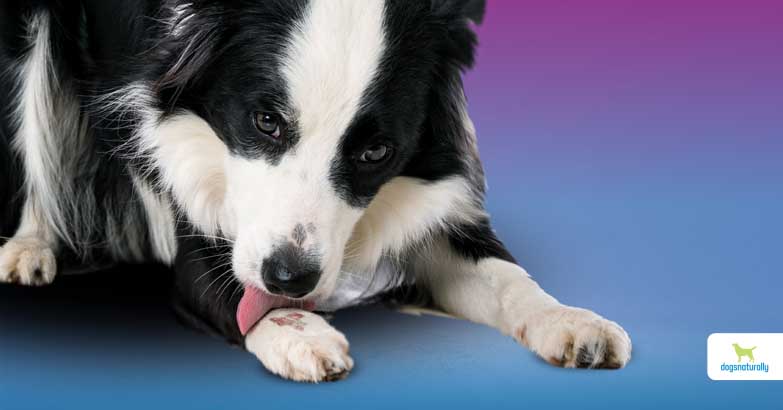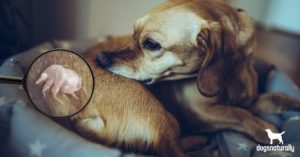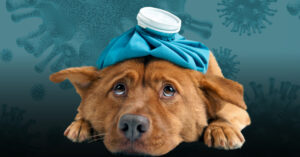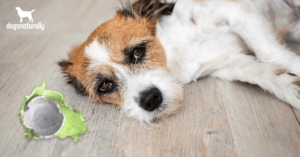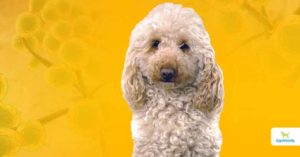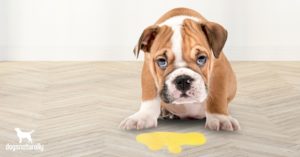Lick granuloma sounds fancy, but you’ll recognize clinical signs of this simple animal behavior almost immediately. It’s the constant licking of one spot on your dog’s leg. It’s red and inflamed and just won’t heal. It’s a constant cycle of itching and licking. That’s a lick granuloma. It’s as stressful for you as it is for your dog.
Aside from the risk of causing a skin lesion, ick granuloma is also a sign of other things that could be going on with your dog. Here’s what a lick granuloma could be hiding and how you can start healing it and other things in your dog’s life.
But first, let’s talk about what it is and how your dog got it.
What Does Lick Granuloma Look Like?
Lick granuloma may also be referred to as acral lick dermatitis or acral lick granulomas. Either way, your furry friend causes this injury to himself through chronic licking.
Usually your dog will lick a spot on the front legs between the elbow and toes …often at the wrist. It might even look like a hot spot.
It becomes a skin lump or raised area where your dog has licked so much he’s removed the fur. And it affects the next layer of skin, and layers deeper than that. Middle-aged, large breed dogs are most often affected.
What Causes Lick Granuloma?
You might think that your dog excessively licking results from boredom. And that can be true. There are other psychological factors like stress and separation anxiety.
But this isn’t always the case. It can also start from underlying conditions such as irritation from a bacterial or yeast infection, furunculosis (ruptured hair follicles), or ruptured apocrine glands (a type of sweat gland). Or it could even be an infestation of skin mites. Any of these underlying problems can make your dog’s itching worse … and that prolongs the vicious cycle of itching and licking.
Itchy skin often triggers the excessive licking that creates this condition. Or a painful skin condition that can lead to itching. These include:
- A leg injury
- Surgery
- Osteoarthritis
- Peripheral neuropathy
- Spinal pain
- Nerve impingement
If it’s an injury, just think about what could be going on in your dog’s mind. He gets a simple sprain from jumping out of a high vehicle. It’s quite sore. Or he’s a little bit arthritic. He doesn’t know how to fix it so he just licks, licks and licks. And pretty soon you have lick granuloma in dogs back.
Sometimes incessant licking has a psychological cause such as canine obsessive-compulsive disorder (OCD). The action of persistent licking triggers the release of endorphins. Your dog learns to repeat the behavior that brings him this pleasant sensation.
It’s important to find the underlying cause of your dog’s licking so it can be successfully treated.
RELATED: Try these allergy remedies that work…
How To Diagnose Lick Granuloma
If your dog doesn’t have behavioral issues, OCD or other psychological disorder or a physical problem, a bacterial infection might be the cause.
When diagnosing this, you need to rule out underlying allergic issues. If your dog has recurrent skin or ear infections, hot spots or itching in other areas, they can point to allergies or environmental factors. Fleas, food or something in your dog’s home or neighborhood environment could be causing the problem. You can do an elimination diet or food sensitivity or testing to rule out food or other environmental allergies or sensitivities.
Testing
You may have to do several tests to confirm a diagnosis of lick granuloma. Your vet might need to do deep skin scrapings (to check for mites), allergy testing, a physical exam, or skin cultures to rule out skin infection too. On rare occasions, a skin biopsy may be necessary to rule out other issues such as cancer.
RELATED: Use this ultimate guide to deal with your dog’s hot spots…
Will A Lick Granuloma Go Away On Its Own?
Lick granulomas don’t heal themselves. You have to get rid of them by stopping the itch-lick cycle. That comes with getting to the root of the skin problem or infection and treating it … and changing your dog’s behavior.
How Long Does A Lick Granuloma Take To Heal?
In most cases, a bacterial infection is the underlying cause of a serious lick granuloma. While it shows up as a wound, bacteria may have spread through your dog’s entire system. And that requires systemic treatment that can take several months.
Most conventional vets will want to prescribe antibiotics over a course of several months. But that’s not ideal. Antibiotics fight bacteria but they also destroy the good bacteria in your dog’s gut. This creates more health problems.
Instead, there are safe, natural antibiotics that will fight the infection. More about these in a bit. First, let’s look at the steps you need to take to start the healing process.
5 Steps To Heal Your Dog’s Lick Granuloma
It can take a variety of steps and several months to eliminate the infection … the first stage in healing your dog’s lick granuloma. Let’s start by addressing your dog’s comfort.
1. Soothe The Itching
These topical solutions can provide relief for the itching.
Fresh Aloe Gel
Aloe vera is antimicrobial and kills bacteria that might infect inflamed skin. It’s ideal for lick granulomas as well as heat rash and hot spots. Its anti-inflammatory properties and cooling nature offer relief. When you use aloe vera, it can speed the healing of skin rashes and provide relief and calm swelling. You’ll need other means to heal a wound like a lick granuloma but aloe helps relieve your dog’s pain and itching. You can apply it three to four times daily
Chamomile Poultice
Chamomile is a herbal that can help inflammation, spasms, ulcers, anxiety and wounds. It makes a soothing antimicrobial rinse. Steep a herbal tea bag of chamomile in a half cup of hot water and let cool. Refrigerate until the infusion chills. You can apply the cold tea bag directly to the wound, and secure it with a light wrap. If your dog won’t tolerate this then dab the solution directly on the wound six to eight times a day.
Next, you want to stop the infection and ensure the affected area stays clean and germ-free. Here’s how.
2. Use Natural Antibiotics To Manage Infection
There are natural antibiotics that can manage an infection without damaging your dog’s microbiome. For topicals, you will want to find a wrap that works to secure a cloth or bandage to hold it in place. Otherwise, you might need to use an e-collar.
You can use these natural options internally and topically for your dog’s infection. Here’s what to put on your dog’s lick granuloma:
Oil of Oregano
Oil of oregano has antibacterial, antiviral, antiparasitic and antifungal properties. It’s quite potent so you only need a little and must dilute it. You can dilute 2 to 3 drops in a tsp of almond oil or MCT oil. Give it to your dog 3 times a day. You can add it to his food to blend it in more as the smell and taste are quite strong.
For topical use, you can mix 1 drop of oregano with 1 tsp of almond oil to increase its antibiotic power. Avoid oil of oregano for dogs with a history of seizures.
Manuka Honey
Manuka honey is from the nectar of the manuka tree (tea tree) and is an excellent topical antibiotic for cuts, wounds and abscesses. It can be applied directly to the affected area. If you want to boost its effectiveness, mix it with colostrum to stimulate wound healing.
Olive Leaf
Olive leaf is another multi-functional natural remedy. It’s from the olive tree and it’s antimicrobial, antibacterial, antiviral and antifungal. Olive leaf doesn’t harm the beneficial bacteria in your dog’s gut. It targets the bad bacteria and leaves the microbiome intact … so both the dog and gut stays healthy. It’s available in powder. You can dose your dog based on his size:
- Small Dogs … ¼ tsp daily
- Medium Dogs … ½ tsp daily
- Large Dogs … 1 tsp daily
Plantain
Plantain is a common weed you’ll find just about anywhere. It’s antibacterial and anti-inflammatory and contains a phytochemical called allantoin. Allantoin kills germs, speeds up healing, and stimulates skin growth. As a topical, you can grind up the leaves and apply them to the trouble spot.
Goldenseal
The roots and leaves of goldenseal have antiviral and anti-inflammatory properties. You can buy it as a tincture and apply it to your dog’s lick granuloma. As a disinfectant, you can put a small amount on a washcloth and apply it to your dog’s wound.
Calendula
This multipurpose flower has anti-inflammatory, antifungal and anti-microbial properties. It also relieves joint pain and helps heal wounds and is a great antibiotic alternative. It’s available as a tincture used internally or topically. Use it internally by adding a few drops to your dog’s food.
To use topically, add 20-40 drops of tincture to a cup of purified water with 1/4 tsp of salt. Dip a cotton ball and dab onto the lick granuloma several times throughout the day. You can also drip directly onto the wound. Or you can buy calendula cream and use that topically.
3. Look Into Alternative Therapies
Cold laser therapy and the Assisi loop (a pulsed electromagnetic frequency device) may be helpful in some cases. Acupuncture can be an excellent supplemental therapy for chronic cases. Ask a chiropractor to check your dog for misalignments. They can be a source of hidden pain which leads to the licking. Sometimes energy work such as Reiki can also reduce your dog’s obsessive licking.
You can also work with a homeopathic veterinarian or practitioner. Homeopathy can address the underlying reasons for the licking, even if it’s psychological. Your homeopath local veterinarian will look beyond the physical aspects acral lick granuloma and look at your dog’s overall condition. That will lead them to choose a remedy to prevent licking and subsequent remedies to heal the lick granuloma. To find a veterinary homeopath, go to theavh.org. Most will work remotely so they don’t have to be local.
4. Protect The Lick Granuloma
Should I cover a lick granuloma?
If you cover the lick granuloma, your dog may start licking another spot and cause a secondary lick granuloma there. But once you start treating the wound, you’ll want to cover it to protect the remedy. You can apply a light, non-stick bandage over the wound, taking care not to make it too tight. Many dogs will lick or chew off the bandage (and even eat it), so this isn’t a solution for everyone.
You might have to resort to using an Elizabethan collar (e-collar) or cone to get your dog to stop bothering the wound while it heals. But there are other things to try first, like activity and exercise mentioned in detail below. Keeping your dog busy with exercise and play might make him want to sleep instead of licking. It will also help break the obsessive itch-lick cycle.
5. Address Behavioral And Psychological Issues
Once you find out why your dog is constantly licking, you want to stop or minimize the constant licking, as much as possible to focus on healing. And you want to address the cause of repetitive licking … which could be boredom or psychological issues.
Add Activity And Exercise
A well-balanced dog needs playtime and activities that stimulate his brain. He also needs a balanced whole food diet, a consistent daily routine and regular interaction with you.
When a dog is crated for several hours a day it leads to loneliness and boredom. That aggravates anxiety-based behaviors like chronic licking.
Often a good place to start is by increasing the amount of exercise your dog gets. Large breed dogs need lots of physical activity. Exercise can relieve his pent-up energy. Longer walks or more time spent chasing a ball is less time spent licking. And a tired dog is a happy dog. Even adding interactive toys will keep your dog’s mind and body active.
If it’s in the budget, consider hiring a dog walker to get your dog out and about more often. You might invite a young neighbor to come and play with your dog. Or make friends with other dog owners. You can arrange playdates so both dogs have time for socialization.
RELATED: Play these games to ease anxiety…
Address The Psychological Causes
If your dog’s licking is due to psychological or emotional factors underlying disease itself, you’ll need to address those issues to prevent the problem from recurring.
Changes in your dog’s environment can be stressful and trigger behavioral issues. The death of a pet or the addition of a new pet are examples of stressors. During times of stress or change like this, have everyone in the family give extra attention to your dog. Activities like agility training can be beneficial for stressed dogs.
It’s also important to resolve conflicts in your dog’s life. These may be things like separation anxiety, problems between animals in the home or long periods of confinement or boredom.
There are some calming herbs and remedies you can use, which you’ll see next. You definitely want to avoid using prescribed anti-depressants.
Why You Shouldn’t Use Anti-Depressants For Lick Granuloma
Conventional veterinarians prescribe anti-depressants or anti-anxiety drugs for dogs experiencing stressful situations … for short and long-term use. These include Prozac, Lexapro and Zoloft, even though they aren’t FDA-approved for dogs. These drugs are powerful and have serious side effects that include:
- Restlessness
- Vomiting
- Diarrhea
- Seizures
- Muscle tremors
- Hyperactivity
- Fever
- Sensitivity to sound
- Drooling
- Disorientation
- Neurological problems
There are much safer, natural remedies to use instead.
Use These Natural Anti-Anxiety Remedies
If anxiety is causing your dog’s lick granuloma these are some calming options:
- CBD oil
- Melatonin
- Chinese herbs through a Chinese medicine practitioner
- Chamomile, valerian and St. John’s Wort, which are soothing herbs to try in tea, tincture or capsule form
- Bach Flower Essences
RELATED: 6 natural remedies to relieve your dog’s anxiety…
Being aware of your dog’s emotional and physical health is key to managing a lick granuloma before it becomes serious. As always, it’s better to prevent it than deal with it when it’s fully inflamed.
How Do You Prevent Lick Granuloma?
You need to deal with any obsessive licking at the first sign of it. Lick granulomas can develop within a matter of hours … and often overnight while you’re asleep. Here are other things you can do:
- Your dog is a member of the family and needs to be included in daily life. That means interaction and exercise to keep him engaged and involved. That stops boredom from setting in and licking that can become chronic and infected.
- Develop the habit of running your hands over your dog. Check for damp fur or sensitivity, especially down the front legs.
- If your dog is hiding from you, check him frequently to ensure he isn’t hiding his obsessive licking from you. Stained fur is a sure sign he’s licking.
- If he’s licking a spot but there’s no injury to the skin, lightly wrap the area in an athletic bandage to discourage further licking.
- If you suspect an underlying condition that will get worse, check with your holistic veterinarian.
Lick granulomas are a sign of other issues so you need to get them looked after as soon as possible. Being attentive to your dog’s emotional and physical needs will help stop this nasty wound.
FAQ
How do you treat a lick granuloma? Treating a lick granuloma involves addressing the underlying cause. This may include behavior modification, medication for anxiety or inflammation, topical treatments, topical therapy, or bandaging to prevent further licking.
Are lick granulomas painful for dogs? Lick granulomas can be painful for dogs, especially as they become inflamed or infected due to constant licking and chewing.
Why do dogs get granulomas? Dogs get granulomas due to persistent licking of an area, often triggered by stress, anxiety, boredom, allergies, or underlying pain, leading to skin irritation and the development of granulomas.
What is the difference between a lick granuloma and a hotspot? A lick granuloma is a chronic, raised skin lesion caused by constant licking, typically on a limb, while a hotspot is an acute, raw, and moist area of skin inflammation that can appear anywhere on the body, often resulting from allergies, skin infections, or insect bites.

